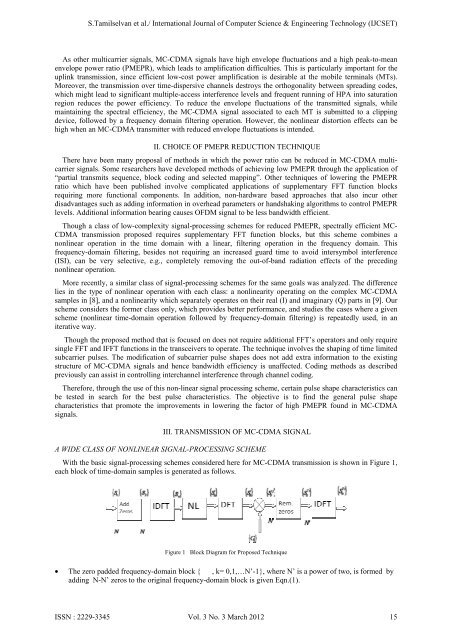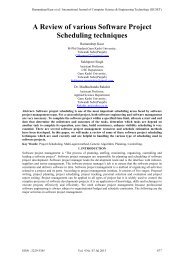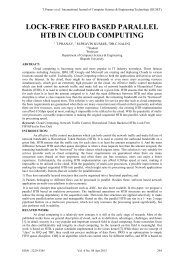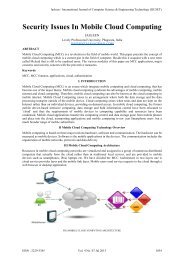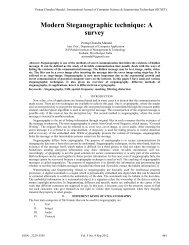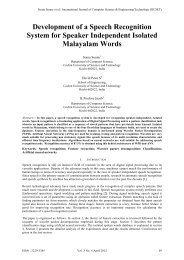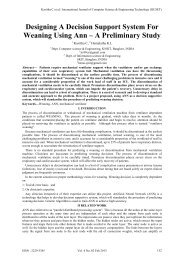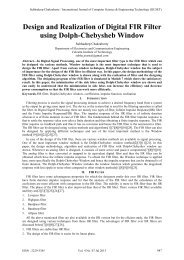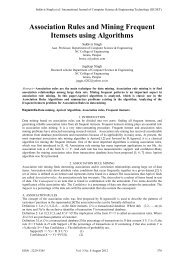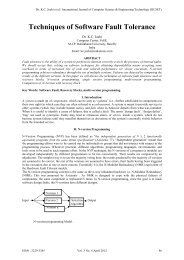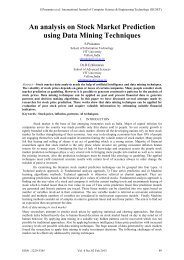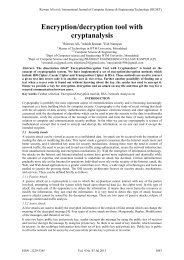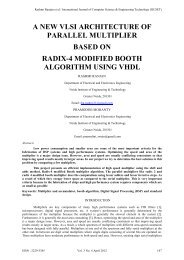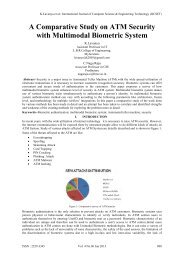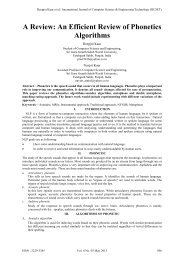a non-linear scheme for pmepr reduction in mc-cdma system - IJCSET
a non-linear scheme for pmepr reduction in mc-cdma system - IJCSET
a non-linear scheme for pmepr reduction in mc-cdma system - IJCSET
You also want an ePaper? Increase the reach of your titles
YUMPU automatically turns print PDFs into web optimized ePapers that Google loves.
S.Tamilselvan et al./ International Journal of Computer Science & Eng<strong>in</strong>eer<strong>in</strong>g Technology (<strong>IJCSET</strong>)• The zero padded frequency-doma<strong>in</strong> block { , k= 0,1,…N’-1}, where N’ is a powerof two, is <strong>for</strong>med byadd<strong>in</strong>g N-N’ zeros to the orig<strong>in</strong>al frequency-doma<strong>in</strong> blockis given Eqn.(1).As other multicarrier signals, MC-CDMA signals have high envelope fluctuations and a high peak-to-meanenvelopee power ratio (PMEPR), which leads to amplification difficulties. This is particularly important <strong>for</strong> theupl<strong>in</strong>k transmission, s<strong>in</strong>ce efficientlow-cost power amplification is desirable at the mobile term<strong>in</strong>als (MTs).Moreover, the transmission over time-dispersivechannels destroys the orthogonality between spread<strong>in</strong>g codes,which might lead to significant multiple-access <strong>in</strong>terference levels and frequent runn<strong>in</strong>g of HPA <strong>in</strong>to saturationregion reduces the power efficiency. To reduce the envelope fluctuations of the transmitted signals, whilema<strong>in</strong>ta<strong>in</strong><strong>in</strong>g the spectral efficiency, the MC-CDMA signal associated to each MT is submitted to a clipp<strong>in</strong>gdevice, followed by a frequency doma<strong>in</strong> filter<strong>in</strong>g operation. However, the<strong>non</strong><strong>l<strong>in</strong>ear</strong> distortion effects can behigh when an MC-CDMA transmitter with reduced envelope fluctuations is <strong>in</strong>tended.II. CHOICE OF PMEPR REDUCTION TECHNIQUEThere have been many proposal of methods <strong>in</strong>which the power ratio can be reducedd <strong>in</strong> MC-CDMA multi-ofcarrier signals. Some researchers have developedd methods of achiev<strong>in</strong>g lowPMEPR through the application“partial transmits sequence, block cod<strong>in</strong>g and selected mapp<strong>in</strong>g”. Other techniques oflower<strong>in</strong>g thePMEPRratio which have been published <strong>in</strong>volve complicated applications of supplementaryFFT function blocksrequir<strong>in</strong>gmore functional components. In addition, <strong>non</strong>-hardware basedapproaches that also <strong>in</strong>cur otherdisadvantages such as add<strong>in</strong>g <strong>in</strong><strong>for</strong>mation <strong>in</strong> overhead parameters or handshak<strong>in</strong>g algorithms to control PMEPRlevels. Additional <strong>in</strong><strong>for</strong>mation bear<strong>in</strong>g causes OFDM signal to be less bandwidth efficient.Though a class of low-complexity signal-process<strong>in</strong>g <strong>scheme</strong>s <strong>for</strong> reduced PMEPR, spectrally efficient MC-aCDMA transmission proposed requires supplementary FFTfunction blocks, but this <strong>scheme</strong> comb<strong>in</strong>es<strong>non</strong><strong>l<strong>in</strong>ear</strong>operation <strong>in</strong>the time doma<strong>in</strong> with a <strong>l<strong>in</strong>ear</strong>, filter<strong>in</strong>g operation <strong>in</strong> the frequency doma<strong>in</strong>. Thisfrequency-doma<strong>in</strong> filter<strong>in</strong>g, besidess not requir<strong>in</strong>g an <strong>in</strong>creased guard time to avoid <strong>in</strong>tersymbol <strong>in</strong>terference(ISI), canbe very selective, e.g., completely remov<strong>in</strong>g theout-of-band radiation effects of the preced<strong>in</strong>g<strong>non</strong><strong>l<strong>in</strong>ear</strong>operation.More recently, a similar class of signal-process<strong>in</strong>g <strong>scheme</strong>ss <strong>for</strong> the samegoals was analyzed. The differencelies <strong>in</strong> the type of <strong>non</strong><strong>l<strong>in</strong>ear</strong> operation with each class: a <strong>non</strong><strong>l<strong>in</strong>ear</strong>ity operat<strong>in</strong>g on thecomplex MC-CDMAsamples <strong>in</strong> [8], and a <strong>non</strong><strong>l<strong>in</strong>ear</strong>ity which separately operates ontheir real (I)and imag<strong>in</strong>ary (Q) parts <strong>in</strong>[9]. Our<strong>scheme</strong> considers the <strong>for</strong>mer class only, which provides better per<strong>for</strong>mance,and studies the cases where a given<strong>scheme</strong> (<strong>non</strong><strong>l<strong>in</strong>ear</strong> time-doma<strong>in</strong> operation followed by frequency-doma<strong>in</strong>filter<strong>in</strong>g) is repeatedly used, <strong>in</strong> aniterative way.Though the proposed method that is focused on does not require additional FFT’s operators and only requires<strong>in</strong>gle FFT and IFFT functions <strong>in</strong> the transceiverss to operate. The technique <strong>in</strong>volves the shap<strong>in</strong>g of time limitedsubcarrier pulses. Themodificationof subcarrier pulse shapes does not add extra <strong>in</strong><strong>for</strong>mation to the exist<strong>in</strong>gstructure of MC-CDMA signals and hence bandwidth efficiency is unaffected. Cod<strong>in</strong>gmethods as describedpreviously can assist <strong>in</strong>controll<strong>in</strong>g <strong>in</strong>terchannel <strong>in</strong>terference through channel cod<strong>in</strong>g.There<strong>for</strong>e, through the use of this<strong>non</strong>-<strong>l<strong>in</strong>ear</strong> signal process<strong>in</strong>g <strong>scheme</strong>, certa<strong>in</strong> pulse shape characteristics canbe tested<strong>in</strong> search <strong>for</strong> the best pulse characteristics. Theobjective is to f<strong>in</strong>d thegeneral pulse shapecharacteristics that promote the improvements <strong>in</strong> lower<strong>in</strong>g the factor of high PMEPRfound <strong>in</strong> MC-CDMAsignals.III. TRANSMISSION OF MC-CDMA SIGNALA WIDE CLASS OF NONLINEAR SIGNAL-PROCESSING SCHEMEWith the basic signal-process<strong>in</strong>g<strong>scheme</strong>s considered here <strong>for</strong> MC-CDMAtransmission is shown <strong>in</strong>Figure 1,each block of time-doma<strong>in</strong> samples is generated as follows.Figure 1 BlockDiagram <strong>for</strong> Proposed TechniqueeISSN : 2229-3345 Vol. 3 No. 3 March 2012 15


